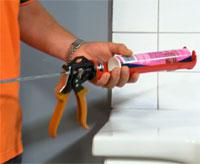| How To Use Silicone Sealant | |||
|---|---|---|---|
| Date:2013-12-31read:940 | |||
|
Instructions Silicone is used to seal joints between two surfaces. It can be used indoors or outdoors, between almost any surfaces. It's pretty useful stuff to have around the home. But there is more than one kind, and a few things you need to know to help you get the best out if it. Getting Started Selecting Your Sealant To choose the right sealant for the job, first take a close look at the problem you're trying to fix – where is the gap, how big is it, what weather conditions will it face, do I want to paint over it? For first time users the range of sealants on the market can be quite daunting. At Mitre 10, however, you'll find experts on hand to give you the right advice on which sealant to use. The Sealant Guide Window & Glass Sealant Uses: Windows, doors, aquariums, light fittings, awnings, refrigerator gaskets, exhaust fans. Features: Adheres strongly to glass, is flexible and non-staining. Bathroom & Tile Sealant Uses: Virtually all surfaces found in bathrooms, laundries, toilets and kitchens. Features: Built-in mould and mildew inhibitor, excellent adhesion to most hard surfaces. Roof & Gutter Sealant Uses: Guttering, downpipes, aluminium and galvanised iron roofing, sheet metal and garage doors. Features: Doesn’t corrode metal surfaces or cause rusting. Ideal for most roofing, guttering and wall systems. Brick & Concrete Sealant Uses: Concrete, mortar, stone, fibro, marble, granite, slate and plasterboard. Features: Permanent, flexible, waterproof seal, long working time for difficult applications, won't eat away at surrounding materials. Paintable Sealants Uses: Window frames, door frames, timber, masonry. Features: Most clean up in water, ideal for all house frames which require painting. Sometimes used between pavers to prevent weeds growing through.
Handy Hint Do not use your finger to smooth out sealant, as this can cause mould to grow in the sealant later.
Silicone generally has a shelf life of one to two years if unopened. To ensure that your silicone is fresh enough to work properly, test it on a nonporous surface before you begin your project. Make sure the silicone sticks, comes out of the cartridge smoothly, and most importantly, that it cures in the time it is supposed to. Preparation Surface Preparation Make sure that the surface you are going to silicone is clean, dry and well prepared. This is essential to achieving good adhesion and a smooth bead. Using a utility knife, remove any remnants of old silicone as new silicone will not adhere to it. After you have removed most of the old silicone with a blade (being careful not to scratch the surface), clean any remaining residue with a fine sandpaper or rub with alcohol.If the surface is mildewed, use a concentrated mildew killer after removing the old silicone. Allow to fully dry before applying new silicone. Application Step 1 Make sure that the area you want to silicone is clean and dry. If filling between glass and aluminium, or whenever a smooth straight edge is required, use masking tape and mask off. Take the tube of silicone and, using a utility knife (held at a 45 degree angle), cut the end from the tapered nozzle. The further away from the end of the nozzle you cut, the bigger the bead of silicone that will be available. Step 2 Pull the handle of the caulking gun all the way back and put the tube of silicone in the gun. Turn the handle down and push the handle until it stops against the end of the tube. Step 3 The recommended way to silicone is to “push” the bead of silicone ahead of the nozzle. This prevents air bubbles forming under the sealant. Use constant pressure on the trigger to ensure an even flow of the silicone. Seal the entire length. When you are done, make sure that you turn the handle up so that the pressure on the tube is released. Step 4 Ensure that the silicone bead is unbroken. If it isn't, smooth with the filling knife dipped in a water and detergent solution. Remember to remove the masking tape before the silicone starts to cure.
Sales manager: Kingda Jin, +86-18968965873 QQ: 1472769000 kingda@3xi.cn ; kingda@jiangoutech.com
|
|||
|

